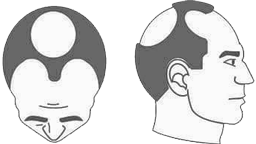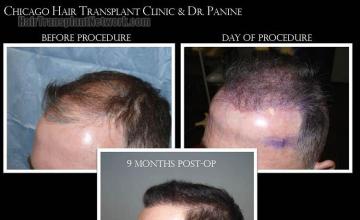Procedure detail
This 43 year old gentleman was a class 5v. He had a previous surgery, performed by another doctor over 10 years ago. That procedure was a strip procedure. He elected to do a FUE procedure this time. After establishing his medical history and understanding the progression of his hair loss, I diagnosed his condition as Androgenetic Alopecia (male pattern baldness), ruling out any other possible dermatological or medical conditions which can cause hair loss. His goal was to achieve a natural looking hairline with as much coverage as possible into the frontal 1/3 of his scalp. I explained that with his degree of hair loss that it would never look as full as before he lost his hair, but he will have enough coverage to change his appearance from the front.
We needed to take his age, present degree of hair loss and possible further hair loss into consideration when planning the surgery. We agreed that it would be best to keep some temple recession, so that he will look good at 43 but also look good as he continues to age. I also explained that if he wanted more density after his first procedure, his donor area would support another procedure in order to continue filling the area farther back. I also explained to him that there was a possibility that he could lose more of his own hair. If this was to happen, the transplanted hair would be able to stand alone and still look natural, but he would need another procedure to bring it back to the way it looks now.
He had a total of 2,978 grafts. The break down was as follows: 1,438 single hair, 1360 two hair grafts and 180 three hair grafts. These are his results 9 months post-op and his result will continue to improve over the next 3-6 months. The patient is on Finasteride and is extremely happy with his results.
Bald class

Norwood stage 5V
The two areas of hair loss are larger than in stage 4. They are still separated, but the band of hair between them is narrower and sparser. There is significant hair loss on the top of the scalp (the vertex).





